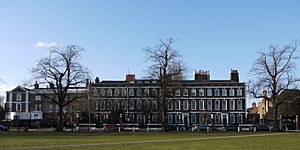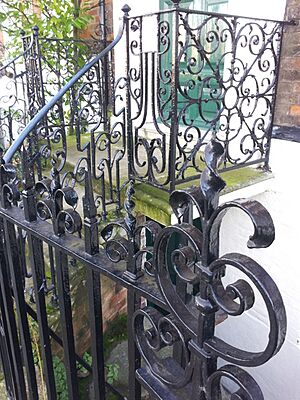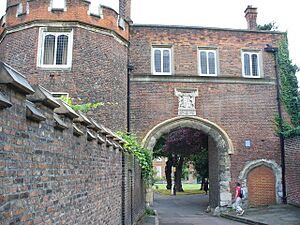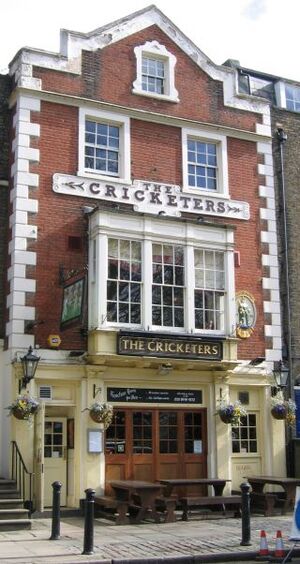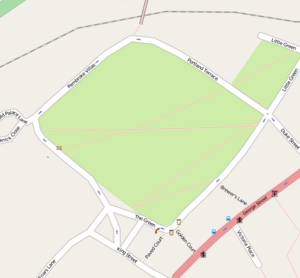Richmond Green facts for kids
Quick facts for kids Richmond Green |
|
|---|---|
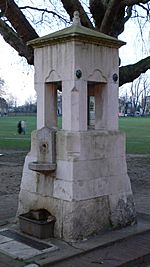
Grade II listed drinking fountain on Richmond Green
|
|
| Type | Village green |
| Location | London |
| Area | 12 acres |
| Operated by | London Borough of Richmond upon Thames |
| Status | Open all year |
Richmond Green is a beautiful open space in Richmond, a town in southwest London. It's like a big, grassy park, about 12 acres in size, surrounded by trees. The Green is owned by the Crown Estate (which manages land for the King or Queen) and is looked after by the London Borough of Richmond upon Thames.
People often call Richmond Green "one of the most beautiful urban greens" in England. There's also a smaller area next to it called Little Green. Both greens are surrounded by old houses, historic buildings, shops, and places like the Richmond Lending Library and Richmond Theatre. It's a popular spot for locals and visitors, especially on sunny weekends. The Green has a long history of hosting sports, from medieval tournaments to cricket matches that still happen today!
Contents
Discovering Richmond Green's History
Richmond Green has been an important place for hundreds of years. In the Middle Ages, kings and queens would visit or live nearby. They even held exciting jousting tournaments right here on the Green!
For over 400 years, houses and shops have been built around the Green. These buildings were for people who worked for or visited Richmond Palace. In 1625, King Charles I even moved his court here to avoid the plague in London. By the early 1700s, these homes were lived in by important people like diplomats and royal staff.
Later, in the mid-1800s, a railway line was built. This separated the Green from Old Deer Park. New houses were built for people who traveled to London for work. In the early 1900s, the A316 road was built, which also added to this separation.
Today, the north, west, and south sides of the Green are mostly homes. The east side, which connects to Richmond's main shopping street (George Street), has many shops and businesses. You'll find pubs and cafes near Little Green, especially by the small alleys like Paved and Golden Courts. These alleys are full of unique, privately owned shops.
To the west of the Green is Old Palace Lane, which leads down to the river. Here you'll find Maids of Honour Row. These are beautiful three-story houses built in 1724. They were made for the "maids of honour," who were trusted royal servants of Queen Caroline. The famous Victorian explorer, Richard Francis Burton, lived at number 2 when he was a child.
Historic Buildings Around the Green
Many buildings around Richmond Green are very old and important. They are "listed," which means they are protected because of their history. For example, numbers 1–6, 11–12, and 32 Richmond Green are all Grade II* listed. This means they are especially important. Other houses like 7–10, 14–18, 21–25, and 29–31 are Grade II listed. Even the fancy iron railings at number 11 are Grade II* listed!
You'll also find two traditional English pubs here: The Cricketers and The Prince's Head. The Richmond Charities, which helps manage homes for people in need, is located at 8 Richmond Green.
Other interesting features include a late 19th-century drinking fountain and two classic red K6 telephone boxes. These are also Grade II listed. There's even an old lamp standard outside 1 Richmond Green that is listed.
The houses on the southwest side of the Green include the famous Maids of Honour Row. The houses, gates, and railings at numbers 1–4 Maids of Honour Row are Grade I listed. This is the highest level of protection for historic buildings.
Some parts of King Henry VII's Richmond Palace still exist. The Wardrobe and the Gate House are both Grade I listed. The Gate House was built in 1501! The Trumpeters' House, built in the early 1700s, is also Grade I listed. It stands where the palace's Middle Gate used to be.
Pembroke Villas and Portland Terrace: Exploring the North Side
The street along the northwest side of Richmond Green is called Pembroke Villas. It has five pairs of large Victorian houses. This area was once home to a famous Dutch businessman, Sir Matthew Decker. His grandson, Richard FitzWilliam, later owned the house, which he called "FitzWilliam House." He collected many artworks there, which later became the famous Fitzwilliam Museum in Cambridge.
The Earl of Pembroke later owned the house and renamed it "Pembroke House." It was taken down in 1840. Today, numbers 1 to 10 Pembroke Villas are Grade II listed.
The street along the northeast side of the Green is Portland Terrace. Numbers 1 to 4 Portland Terrace are also Grade II listed. Between Pembroke Villas and Portland Terrace, there's a gate that used to be the entrance to Old Deer Park. Now, only people walking can use it. A short walk past the gate, a footbridge crosses the railway line to a car park for Old Deer Park. Portland Terrace continues past Little Green and becomes Duke Street, where you'll find Duke Street Church.
Cricket on the Green: A Sporting Tradition
Richmond Green has been a popular place for cricket matches since the 1700s. The very first mention of cricket here was in a letter from 1666!
Today, two local cricket teams play on the Green. Each team is linked to one of the nearby pubs: The Prince's Head and The Cricketers. During the week, they play fast-paced Twenty20 matches, usually on Tuesdays or Thursdays. Local village teams compete for the Len Smith Charity Shield.
Richmond Green in Art
Richmond Green has even inspired artists! Two watercolour paintings by Edward Walker, made in 1942, show parts of Richmond Green. These artworks are now part of the Recording Britain collection at the Victoria and Albert Museum.
Community Groups
The Friends of Richmond Green is a local group that works to "protect and improve the Green." They want to make sure the Green stays beautiful for everyone who lives there, visits, and for future generations.
Images for kids
-
Park Gates House, in Pembroke Villas, is next to the old entrance to Old Deer Park


